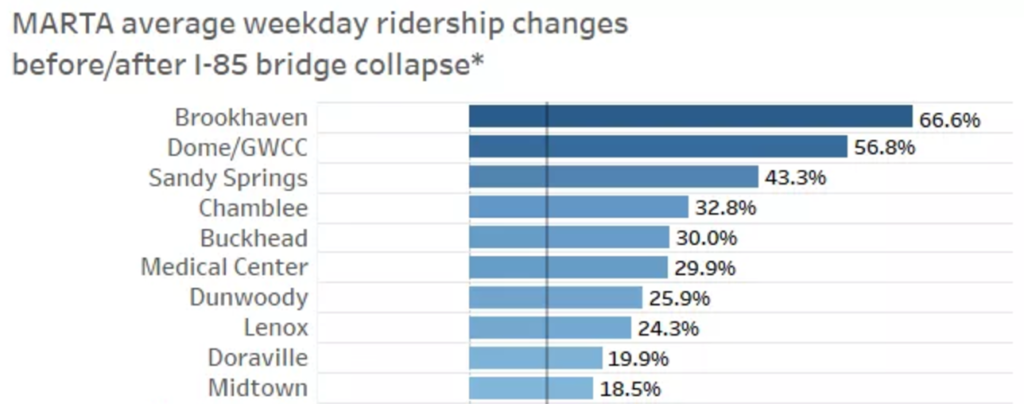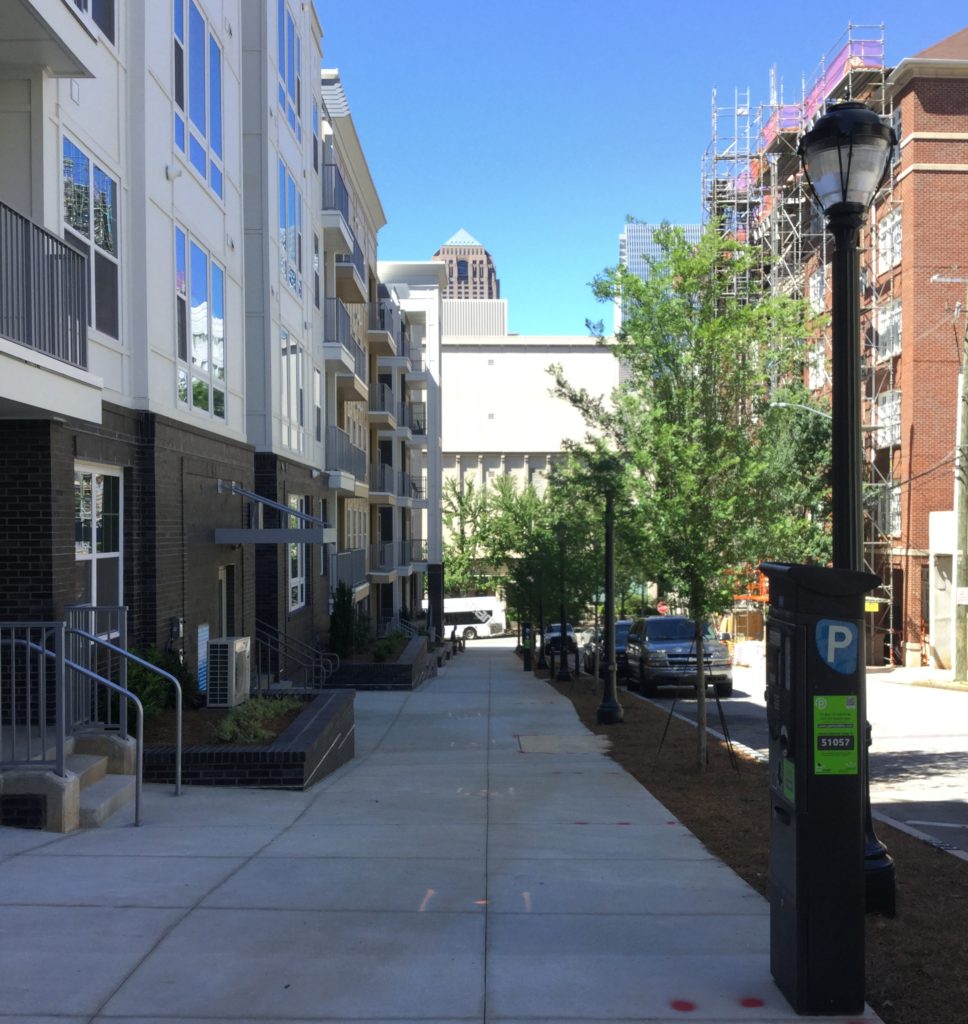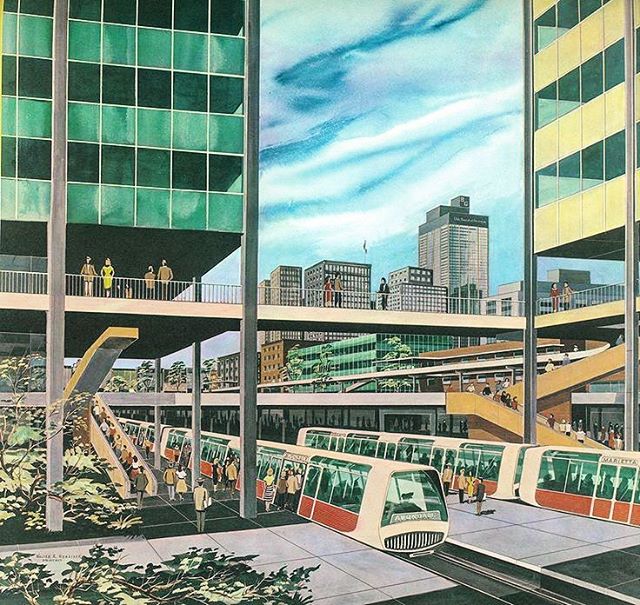In the wake of the I-85 collapse, there was ffect significant rise in MARTA ridership at certain rail stations, mostly the ones on the northern line where interstate commuters were affected. According to a report from the Atlanta Regional Commission, Brookhaven MARTA Station saw a 66% rise in riders and Sandy Springs Station also saw a big increase at 43%.
Something to consider when you see those numbers: they represent a drop in the number of cars that were brought into the job centers of the City of Atlanta, in Midtown and Downtown and Buckhead. Reducing car trips on city streets is beneficial for the neighborhoods around and within those job centers. Less car traffic from commuters makes our streets easier on pedestrians and cyclists and bus riders.
Can we reduce those car trips, long-term? The question everyone’s asking, now that the interstate repairs are complete: will a significant number of these new riders stick with transit after the bridge is repaired?

Whether or not commuter behavior will be changed by this unintended introduction to transit, time will tell. Apart from finding a way to raise the price and availability of parking, there’s a limited amount of things the City government can do to enact a change in commuting behavior on a regional level. On a more local level, an equally important question is this: will our understanding of the built-environment’s effect on transit ridership change after the I-85 experience?
The relationship between transit access and urban design

After the collapse, MARTA added 2,400 new parking spaces to accommodate people driving into rail stations from their suburban homes, and that’s a fine response for short-term needs during the loss of the interstate. But considering that I-85 carries 240k cars per day, this shouldn’t be misconstrued as a long-term fix — we can’t build enough parking spaces to accommodate even half the commuters on that route.
A better scenario would be if this new spotlight on the resiliency of our transportation systems helps Atlantans grasp the important relationship between transit access and urban design. That understanding could result in long-term changes to our urban design, providing a more sustainable source of links between origins and destination points.
A recent post from TransitCenter notes the important connection between transit ridership and walkability. It points to a 2016 survey of more than 3000 transit rider in 17 cities as proof that, the easier it is for people to walk to public transportation, the more likely they are to use it. As the post states: “land use determines transit’s viability.”
Putting more people closer to transit should be a priority for all of our local governments, and the City of Atlanta should lead the way.
Heavy-rail expansion is no quick fix
“The agency expects two of the projects — a MARTA expansion from East Point to Jonesboro and an Atlanta Streetcar extension from Jackson Street to the Beltline at Irwin Street — to be started sometime between 2022 and 2030. The remainder are not scheduled until 2031-40.”
Nobody is stepping off the train in one of those new MARTA stations until the 2030s, at least.
Which highlights the importance of the Atlanta City Design plan for handling our inevitable population growth, because the timeline is much shorter for putting new housing near *existing* transit lines. Expansion of transit is certainly needed, but we have to face the facts about how long that takes and understand the importance of doing what we can in the shorter term for putting people near mobility options — and also how that fits in with the city’s goal for intown growth.
Don’t be fooled by the recent apartment boom: there’s a lot more room for growth
And we’ve got a lot of catching up to do there. Atlanta’s suburban housing boomed over the last three decades. In fact, during the 1990s, the Atlanta region outpaced all other metropolitan areas in the United States except Phoenix, Arizona in its rate of population growth growth.
But that was the region as a whole. If you look more selectively at the area that comprises the full footprint of intown MARTA coverage, population growth was weak during that period, particularly in the City of Atlanta. According to the Atlanta Regional Commission, the City’s rate of population growth in the 1990s was less than 3 percent — and that followed a period of population decline intown during the 1970s and 80s.
The growth in the region was highly divided along urban/suburban lines for decades (and by the way, the suburbs are still booming, making the ‘catch-up’ effort is even harder). The boom happened in the car-centric outskirts, while little was happening near MARTA. The construction of apartments in Midtown and a couple of other hotspots in recent years might look impressive to us, but it’s a drop in the bucket compared to suburban growth.

That makes the housing we do have near transit much more valuable, which likely causes a “supply and demand” type of affordability problem. A recent writeup on that subject focuses on the San Francisco housing crisis but it easily relates to Atlanta:
“Let’s be real. While the new apartment or condo project down the street is expensive, so is the 75-year-old house or apartment you’re trying to buy or rent. It’s *all* expensive, and that’s not because it’s ‘luxury.’ It’s because it’s scarce.”
Important side note: We shouldn’t talk about new development in Atlanta without also discussing the affordability problem. It’s serious. The fact that many people can’t afford to live in the city even if they want to and even if the transit access is something they need — that’s something that needs a lot of attention from multiple levels. Could reducing parking requirements at apartments help (structured parking costs about $25-35k per-space to build)? Can we find a way to reduce construction costs? Could community land trusts help preserve existing affordable housing? Everything needs to be on the table.
Playing catch-up is hard, but necessary
But the topic is even more complex than housing alone, because we also shouldn’t talk about housing growth or transit expansion without addressing the need for housing growth near transit stops, because there’s a decades-long deficit that needs to be corrected.
Catching up after decades of intown housing stagnation is bound to be a difficult process, but we can’t afford to let the difficulty of it stop the process from happening.
Atlanta architect Eric Kronberg has written up some recommendations on how our city’s land use laws could be changed to allow home near transit, thus making it easier for people to have access to destinations through multiple transportation options. He notes the importance of transit-proximity in this effort and the resiliency it affords : “Our car-based transportation systems continue to demonstrate their limited ability to handle disruption…we simply must provide more housing in a dignified fashion closer to transit.”
There are changes to city zoning that are needed to make a sea-change level of good urbanism happen near transit throughout Atlanta’s MARTA coverage area. And that process has begun, but it’s a long one and won’t be completed for several years. One place where no zoning change is required is on property that MARTA already owns — namely, its parking lots. The transit system has been working on putting transit-oriented developments (TOD) on top of those parking lots for a few years now, and some movement is finally happening with construction this year.
Amanda Rhein leads MARTA’s TOD initiative. Since her job is to help create transit-accessible places for people to live and work, I reached out to her to find out if she thinks the interstate shutdown has had an effect on the way that Atlantans feel about the importance of transit, and of developing infill growth near it. She thinks it has, saying that “the I-85 collapse has brought into focus the idea that multi-modality is essential to regional resiliency.”
But is it enough ? Will this experience be forgotten in a few weeks? Anyone who knows this city well understands that the barriers are plentiful. The entrenched culture of car-centric land use here — and the bias among many of having MARTA near their homes — means that a serious change of hearts and minds is needed. Rhein understands this. “Our historic land use patterns have made many people dependent on cars,” she says. “Changing how we think about land use is an important part of creating a region that is more connected and resilient.”
It’s not all about commuting
The focus of this post is mostly on the I-85 collapse and its effect on commuting. It’s an easy kind of trip to highlight, since car commuters very visibly crowd the roads with congestion at certain times of the day.
But an important wrinkle to add to this discussion is that commutes don’t even take up half the miles we travel in a year. According to data from the Federal Highway Administration (from 2009), the “Percent of Total Transit Person Miles Traveled” in the U.S. breaks down like this:
- Commuting: 39 percent
- Work-Related Business Travel: 4.5 percent
- Other Resident and Tourist/Visitor Travel: 56.5 percent
Reducing the number of car trips we make in the city for commuting is definitely important. And transit access is a big part of that. But there are many other places we travel to on a weekly or monthly basis that could be handled without cars, and it takes more than just the presence of transit to accomplish that. For a full range of access to our destinations that lessens car dependency, we’ll need stores and post offices and healthcare to be spread around at neighborhood scale, rather than centrally in commercial developments. But that’s a topic for a another post.
